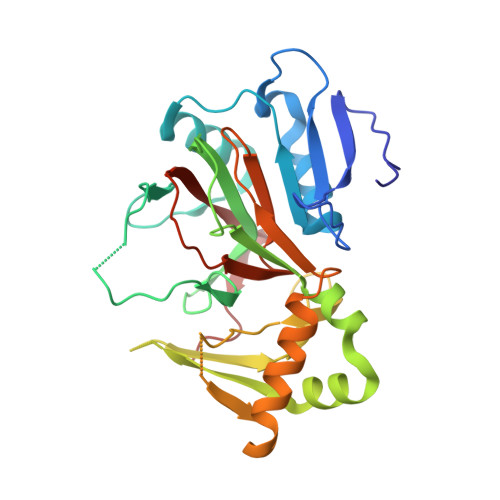Examining Reaction Specificity in PvcB, a Source of Diversity in Isonitrile-Containing Natural Products.
Zhu, J., Lippa, G.M., Gulick, A.M., Tipton, P.A.(2015) Biochemistry 54: 2659-2669
- PubMed: 25866990
- DOI: https://doi.org/10.1021/acs.biochem.5b00255
- Primary Citation of Related Structures:
4YLM - PubMed Abstract:
Many bacteria produce isonitrile-containing natural products that are derived from aromatic amino acids. The synthetic clusters that control biosynthesis most commonly encode two enzymes, designated PvcA and PvcB, as well as additional enzymes that direct synthesis of the natural product. The PvcA enzyme installs the isonitrile moiety at the amino group of either tyrosine or tryptophan, as dictated by the particular pathway. The common pathway intermediate produced by PvcA is directed toward different ultimate products by PvcB, a member of the family of Fe(2+), α-ketoglutarate-dependent oxygenases. To continue our investigation of the structural and functional properties of the isonitrile biosynthetic pathways, we present here a study of the PvcB homologues from three organisms. Two pathways, derived from Pseudomonas aeruginosa and Xenorhabdus nematophila, produce known products. A third PvcB homologue from Erwinia amylovora is part of an uncharacterized pathway. Our results demonstrate the diversity of reactions catalyzed. Although all PvcB enzymes catalyze the hydroxylation of the tyrosine isonitrile substrate, the elimination of the hydroxyl in Pseudomonas and Erwinia is driven by deprotonation at Cα, resulting in the initial production of an unsaturated tyrosine isonitrile product that then cyclizes to a coumarin derivative. PvcB from Xenorhabdus, in contrast, catalyzes the same oxygenation, but loss of the hydroxyl group is accompanied by decarboxylation of the intermediate. Steady-state kinetic analysis of the three reactions and a docking model for the binding of the tyrosine isonitrile substrate in the PvcB active site highlight subtle differences between the PvcB homologues.
Organizational Affiliation:
†Department of Biochemistry, University of Missouri, Columbia, Missouri 65211, United States.















